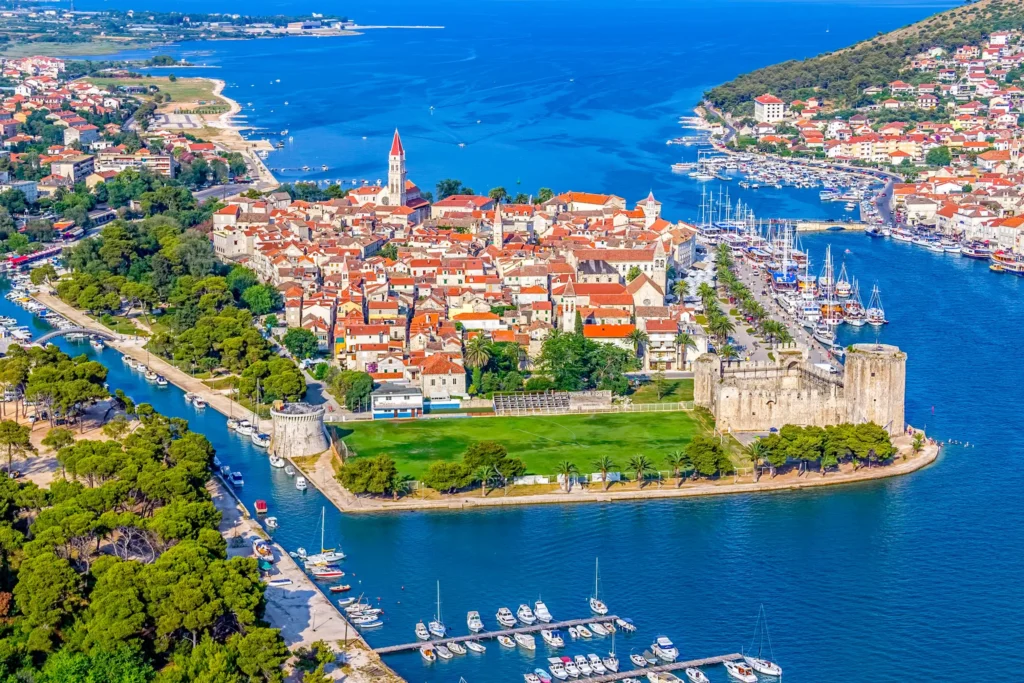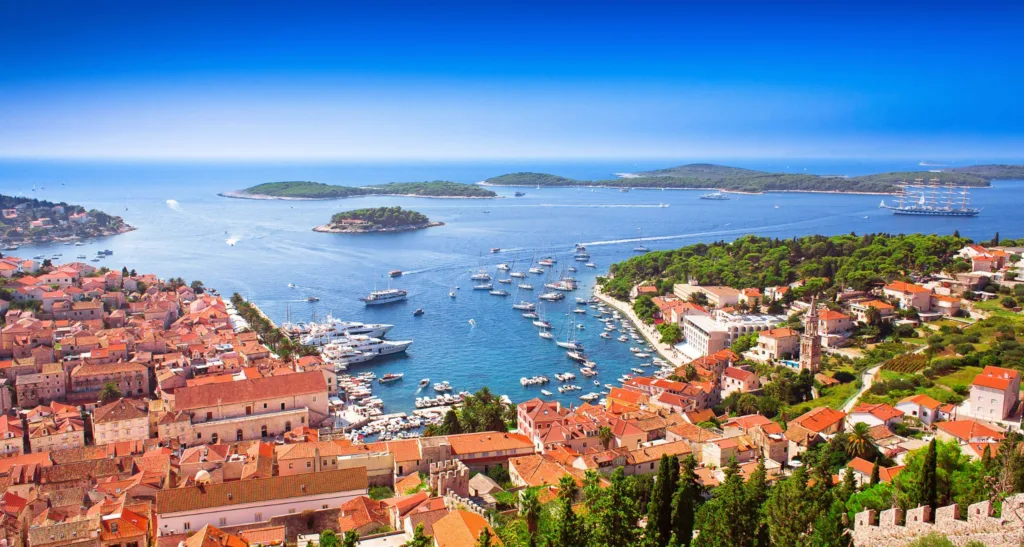Split, nestled within Split County in Dalmatia, Croatia, stands as a beacon of cultural heritage, vibrant city life, and stunning coastal beauty. This city, the second-largest in Croatia, unfolds as a dynamic tapestry of ancient architecture, lively streets, and an inviting Mediterranean atmosphere.

Exploring Split's Rich History
Split’s history is deeply rooted in ancient times, founded as a Greek colony in the 3rd century BC. Its prominence rose with the construction of Diocletian’s Palace in AD 305. This UNESCO World Heritage site remains the city’s heart, showcasing a fusion of Roman, Gothic, and Renaissance architecture.
Diocletian’s Palace: A UNESCO World Heritage Site
At the heart of Split lies Diocletian’s Palace, a monumental structure built in the 4th century for the Roman Emperor Diocletian. This expansive complex forms the city’s old town and is among the best-preserved monuments of Roman architecture globally.
The Cathedral of Saint Domnius
Within the palace grounds stands the Cathedral of Saint Domnius, originally Diocletian’s mausoleum. It’s considered the oldest Catholic cathedral still in use in its original structure. Visitors can climb the bell tower for panoramic views of Split.
Top Attractions in Split
The Riva Promenade
The Riva, Split’s bustling waterfront promenade, is lined with cafes and restaurants, making it a perfect spot for a leisurely stroll or a coffee break while watching the world go by.
Marjan Hill
For nature enthusiasts, Marjan Hill offers hiking trails, shaded paths, and breathtaking vistas of the city and surrounding islands. It’s an ideal escape from the urban hustle.
Split Archaeological Museum
Established in 1820, the Split Archaeological Museum is the oldest museum institution in Croatia. It houses an extensive collection of artifacts from prehistoric times through the early Middle Ages, including Roman glass, ancient clay lamps, and a rich archive library.
Beaches and Outdoor Activities
Bačvice Beach
Located near the city center, Bačvice Beach is famous for its sandy shores and the traditional game of picigin played in the shallow waters. It’s a favorite among locals and tourists alike.
Water Sports and Island Hopping
Split serves as a gateway to the Adriatic Sea, offering numerous water activities such as sailing, kayaking, and diving. Ferry services connect to nearby islands like Hvar, Brač, and Vis, each boasting unique attractions.
Culinary Delights
Split’s gastronomy reflects its rich cultural heritage. Here are some must-try culinary experiences:
Fine Dining
Zrno Soli: A top-tier seafood restaurant located in the ACI Marina, offering fresh, locally sourced dishes.
Dvor: With stunning sea views, this Mediterranean restaurant combines traditional and modern culinary styles.
Traditional Konobas
Konoba Fetivi: Known for authentic Dalmatian dishes like grilled fish and peka (meat or seafood cooked under a bell).
Villa Spiza: A small, cozy spot serving hearty meals with ingredients sourced daily from local markets.
Casual Eateries
Bokeria Kitchen & Wine Bar: A vibrant fusion of Dalmatian and international flavors, inspired by Barcelona’s La Boqueria market.
Kantun Paulina: Perfect for a quick and delicious cevapi sandwich, a local favorite for over 50 years.
Don’t forget to pair your meals with local wines like Plavac Mali or Pošip for an authentic experience.
Accommodation Options
Split offers a wide range of accommodations to suit every traveler:
Hotels
Hotel Park Split: A five-star hotel near Bačvice Beach with a spa and fine dining.
Judita Palace Heritage Hotel: Located within Diocletian’s Palace, combining history and luxury.
Hotel Luxe: Contemporary rooms with sea views, located just steps from the old town.
Cornaro Hotel: Modern amenities and a rooftop terrace with panoramic city views.
Budget-Friendly Options
- Hostel Split: Located in the center of Split, just 500 meters from the Adriatic Sea, this hostel offers air-conditioned rooms and free WiFi in public areas. Each room is equipped with a flat-screen cable TV and wooden floors.
- Old Town Hostel Split: Set within Diocletian’s Palace, this hostel provides a shared lounge and free WiFi. It’s a non-smoking property, ensuring a comfortable stay for all guests.
Camping in Split
For those seeking a closer connection to nature, Split has excellent campsites:
Camping Stobreč Split: Located 7 km from the city center, this campsite offers river and sea experiences, modern facilities, and sports activities.
Amadria Park Camping Trogir: Located in Seget Vranjica, approximately 5 km from Trogir and 30 km from Split, this campsite offers terraced pitches with stunning sea views. Amenities include a swimming pool, sports facilities, and a pebble beach. Its proximity to both Trogir and Split makes it a convenient base for exploring the region.
Check offers from our partners

Events and Festivals
Split hosts a variety of events throughout the year.
Split Summer Festival
Held annually, the Split Summer Festival features theater performances, concerts, and operas, utilizing the city’s historic sites as unique venues.
Ultra Europe Music Festival
Since 2013, Split has been home to the Ultra Europe electronic music festival, attracting international DJs and music enthusiasts to the Poljud Stadium.
Practical Information
Getting There
Split is accessible by various means:
By Air: Split Airport, located approximately 24 km from the city center, connects to numerous European destinations. Shuttle buses and taxis are available for transfers.
By Ferry: The Port of Split is a major hub, with regular ferry services to surrounding islands and international routes to Italy.
By Train: Split’s railway station offers connections to major Croatian cities, though services may be limited compared to other modes of transport.
Best Time to Visit
The ideal time to visit Split is between May and September when the weather is warm, and the sea is perfect for swimming. July and August are peak tourist months, so for a more relaxed experience, consider visiting in May, June, or September.
Local Tips
Currency: Croatia uses the Euro (€). ATMs are widely available, and credit cards are accepted in most establishments.
Language: While Croatian is the official language, English, Italian, and German are commonly spoken, especially in tourist areas.
Dress Code: Casual attire is acceptable in most places. However, when visiting religious sites like the Cathedral of Saint Domnius, it’s advisable to dress modestly.
FAQs About Split
What is the significance of Diocletian’s Palace?
Diocletian’s Palace is a UNESCO World Heritage site and one of the best-preserved monuments of Roman architecture in the world. Built as a retirement residence for Emperor Diocletian, it forms the heart of Split’s old town and is a living part of the city’s vibrant culture.
What are some of the best beaches in Split?
Bačvice Beach is popular for its sandy shores and lively atmosphere. Kašjuni Beach is another excellent option for those looking for a quieter spot beneath Marjan Hill.
Is Split a good base for exploring nearby islands?
Yes, Split is an ideal base for island hopping. Regular ferries connect the city to islands like Hvar, Brač, and Vis, making it easy to explore the Adriatic Sea.
Are there family-friendly activities in Split? (H3)
Absolutely! Split offers family-friendly beaches, hiking trails on Marjan Hill, and numerous cultural sites that are enjoyable for all ages.
What local dishes should I try in Split? (H3)
You should try black risotto, pašticada, and fresh seafood. Pair your meal with local wines like Plavac Mali or Pošip for an authentic Dalmatian experience.
Conclusion
Split’s unique blend of historical charm, natural beauty, and modern amenities makes it a captivating destination. Whether you’re exploring ancient landmarks, enjoying the beaches, or dining on delicious Dalmatian cuisine, Split promises an unforgettable experience.
Disclosure: This page may contain affiliate links. This means that we get a small commission from any purchase you make, at no additional cost to you!

